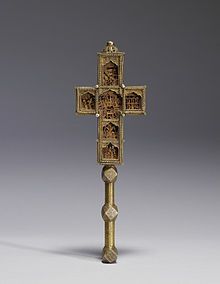Domentius IV of Georgia
| Domentius IV | |
|---|---|
Gurieli | |
| Religion | Georgian Orthodox Church |
| Khelrtva |  |
Domentius IV (
Family and early life
Domentius was born in 1677 into the royal family of Kartli. His father was Levan, the Georgian prince royal and a nominal convert to Islam as Shah-Quli Khan, who was briefly titular king of Kartli in 1709. His mother, Tuta Gurieli, of the
First patriarchal term

In 1705, Domentius, then aged around 28, was elected the head of the Georgian Orthodox Church after the synod convened by his brother Vakhtang, regent of Kartli for his absent uncle, George XI (Gurgin Khan), accused the catholicos Eudemus II of "ignorance" and removed him from the position. The Safavid government of Iran, claiming sovereignty over Kartli, tolerated Vakhtang's support of the church owing to the contribution of the Georgian royals fighting on the Afghan front.[4][5][3]
By the time of Domentius's accession, the Georgian church had been split into the two, eastern and western counterparts, reflecting the political division of the country back in the 15th century. Domentius, albeit holding sway only of the eastern church, embarked on a program to restore the prestige and influence of the Georgian catholicosate. Inclined to underscore his hierarchical supremacy, the new prelate resumed using the title of patriarch, for a time forgotten by the Georgian catholicoi as their church had experienced decline under the Iranian hegemony. He exploited his royal origin and wealth to restore the churches and monasteries across the country, commissioned copies of old manuscripts, had the Greek Breviary translated and published—one of the first books printed in Georgia—in Tbilisi in 1719.[3]
In 1708, Domentius reclaimed the former catholicosal holdings from David II (Imam-Quli Khan), a Muslim Georgian king of Kakheti. To this end, the patriarch had traveled, in 1707, to Iran in order to convince the shah to force his reluctant vassal in Kakheti into concessions. The 18th-century European authors such as Judasz Tadeusz Krusinski and the Capuchin missionary Pierre d'Issoudun report that Domentius, while visiting Iran, offered to unfrock himself, marry and convert to Islam, hoping to accede to the throne of Kartli. For this, Krusiński claims, Levan, himself a Muslim, had him thrashed on the soles of his feet.[6] While the trustfulness of these reports remain disputed to this day, the rumors were current in Domentius's time as suggested in the historical poem Bakariani written by the catholicos's companion Iese Tlashadze.[3]
In 1712, the shah
Exile and the second term
In 1719, Vakhtang VI, having accepted Islam, returned to rule Kartli. Domentius's tenure remained undisturbed until 1723, when Kartli was invaded by the Ottoman army, forcing Vakhtang VI into exile to Russia. The catholicos himself withdrew to
Ancestry
| Ancestors of Domentius IV of Georgia | ||||||||||||||||||||||||||||||||||||||||||||||||||||||||||||||||||||||||||||||||||||||||||||||||||||||||||||||||||||||||||||||||||||||
|---|---|---|---|---|---|---|---|---|---|---|---|---|---|---|---|---|---|---|---|---|---|---|---|---|---|---|---|---|---|---|---|---|---|---|---|---|---|---|---|---|---|---|---|---|---|---|---|---|---|---|---|---|---|---|---|---|---|---|---|---|---|---|---|---|---|---|---|---|---|---|---|---|---|---|---|---|---|---|---|---|---|---|---|---|---|---|---|---|---|---|---|---|---|---|---|---|---|---|---|---|---|---|---|---|---|---|---|---|---|---|---|---|---|---|---|---|---|---|---|---|---|---|---|---|---|---|---|---|---|---|---|---|---|---|
| ||||||||||||||||||||||||||||||||||||||||||||||||||||||||||||||||||||||||||||||||||||||||||||||||||||||||||||||||||||||||||||||||||||||
Notes
- ^ Burgess 2005, p. 151.
- ^ Ioselian 1866, p. 204.
- ^ a b c d e f Kavtaria 2002, [1].
- ^ Rayfield 2012, p. 223.
- ^ Lang 1957, p. 77.
- ^ Rayfield 2012, p. 224.
References
- Burgess, Michael (2005). The Eastern Orthodox Churches: Concise Histories with Chronological Checklists of Their Primates. McFarland. ISBN 0786421452.
- Ioselian, Plato (1866). Williams, George (ed.). A Short History of the Georgian Church. London.
{{cite book}}: CS1 maint: location missing publisher (link) - Kavtaria, Mikheil (2002). "რამდენიმე საკითხი დომენტი კათალიკოსის ბიოგრაფიიდან" [Some problems of the biography of Catholcios Domenti]. Literaturuli Dziebani (in Georgian). 23 (I). National Parliamentary Library of Georgia. Retrieved 1 October 2013.
- Lang, David Marshall (1957). The Last Years of the Georgian Monarchy, 1658-1832. New York: Columbia University Press.
- ISBN 978-1780230306.
